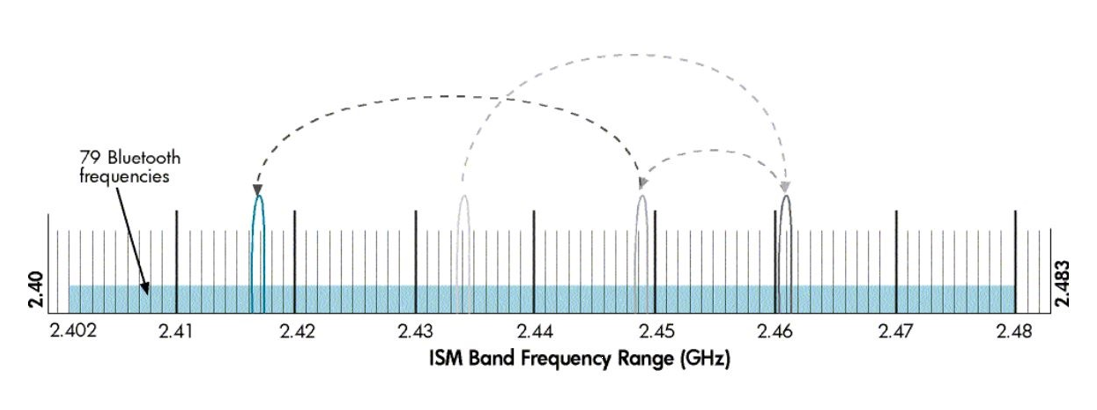Bluetooth facts and figures
How does Bluetooth work
The simplest explanation for how Bluetooth works is that data/audio is continuously transferred from a paired Bluetooth transmitter to a paired receiver. Pairing is just the bonding procedure between devices so that you don’t have to enter access or security information, like passwords or passkeys, each time the devices need to establish a connection. Bluetooth operates in the frequency range of (2.402 -2.480GHz). Once a secure connection is established between a transmitter and receiver, data is split into small packets, which are then transferred at alternating frequencies. The type of Bluetooth and profiles may vary, but the core architecture remains the same. To avoid interference with other devices that may also use the ISM (industrial, science, and medical) bandwidth of 2.4Ghz, Bluetooth devices randomly hop between frequencies 1600 times per second until all the packets are transferred.
Bluetooth version and profiles
The NGTC-BTI supports Bluetooth 5.x, the most recent iteration of Bluetooth. It has twice the bandwidth of V4.x. The NGTC-BTI supports only audio related transmission, no data communication or phone/handsfree functionality.
Stereo audio transmission. This is the most important profile for Bluetooth as mono audio is not suited for listening to music.
Adds control for media playback such as skipping tracks, play/pause, and meta data.
Which Bluetooth Codec is the best?
Codecs are encoding and decoding algorithms that compress audio into manageable data packets for faster or wireless transmission. The efficiency of the codec will determine the quality and rate at which the audio data is sent. SBC is the default sub-band coding for most Bluetooth devices. However, since this codec has a relatively high latency and may be a bit lossy, companies have developed their own encoding algorithms.
The mandatory and default codec for all stereo Bluetooth headphones with the Advanced Audio Distribution Profile (A2DP). It is capable of bit rates up to 328 kbps with a sampling rate of 44.1kHz. It provides fairly good audio quality without requiring a lot of processing power to encode or decode. However, the audio quality can be a bit inconsistent at times. This is especially noticeable with a cheap Bluetooth transmitter.
Similar to SBC, but with better sound quality. This codec is mostly popular with Apple’s iTunes platform and some other non-wireless applications. However, it’s not very common, especially for headphones.
It’s ideal for demanding audio applications since it encodes audio more efficiently and at a slightly higher rate than SBC. There are also two additional variations, aptX Low Latency and aptX HD, that either drastically reduces the latency of the connection or significantly improves its audio quality. However, it’s a bit limiting, as both the Bluetooth transmitter and receiver must have aptX or its variations for the codec to work.
Latency
Codecs have a bigger impact on latency than on sound quality for most listeners. The default SBC connection typically has more than 100ms of latency, which is noticeable when listening to music but may be severe enough to ruin your movie experience. To fix some of the sync issues caused by latency, CSR developed the aptX and subsequently the aptX Low Latency codec. Regular aptX does somewhat improve latency due to its more efficient encoding algorithm than SBC. However, aptX-LL has the most noticeable impact on latency.
| Codec | Latency |
|---|---|
| SBC | 173ms |
| aptX | 166ms |
| aptx LL | 34ms |
Conclusion
Codecs are the algorithms that compress data for easier and faster transmission. Better encoding and decoding algorithms mean less lossy transmission which can help with audio quality. We have noticed that codecs have a bigger impact on latency than on audio quality. The subtle changes in audio quality due to a codec like aptX are negligible when compared to the reduced latency aptX Low Latency connection. However, since both Bluetooth devices (source/sink) have to support the codec for it to work, you will most often rely on the default sub-band coding (SBC), as there are not many Bluetooth devices that support aptX and even less for aptX-LL.
